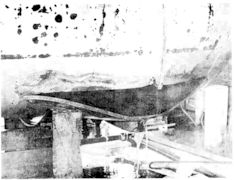Sequoyah Fuels Corporation
Sequoyah Fuels Corporation owned and operated a uranium processing plant near Gore, Oklahoma. The company was created in 1983 as a subsidiary of Kerr-McGee. In 1988 it was sold to General Atomics[1][2]
Uranium processing plant
The plant is located near Gore, Oklahoma, close to the Illinois River and Interstate 40. The plant started construction in 1968 and began operation in 1970. It converted yellowcake uranium into uranium hexafluoride. In 1987 it started converting depleted uranium hexafluoride into depleted uranium tetrafluoride. The plant ceased operation in 1993.[3]
The plant was operated under Kerr-McGee Nuclear Corporation.[4] In 1983 KMNC split into Quivira Mining Corporation and Sequoyah Fuels Corporation. The latter was given control of the plant. In 1988 Sequoyah Fuels Corporation was sold to General Atomics.[3]
In 2008 a company named International Isotopes said it would buy equipment and intellectual property from the Sequoyah Fuels Corp plant. The equipment would be used in a new location. It would be used for converting depleted uranium hexafluoride to depleted uranium tetrafluoride.[2]
The 1986 Sequoyah Corporation Fuels Release in Oklahoma

On January 4, 1986, just 4 months before the Chernobyl release, Sequoyah Fuels Corporation experienced a rupture in an overfilled UF6 cylinder that contained an estimated 29 500 pounds of gaseous UF6 (an event that is described in Nuclear Regulatory Commission reports20, 21 and an academic article16; Table 1). The incident led to the death of a 26-year-old worker, James Harrison, of African American and Cherokee heritage, and the hospitalization of 37 of the 42 onsite workers. Health care providers examined up to 100 people, many from the community, for health effects, and 21 were hospitalized for short periods.[5]
Quotes from American Journal of Public Health
"At the Sequoyah Fuels Corporation facility in eastern Oklahoma, yellow cake was treated with nitric acid for the purification and extraction of uranium."
...
"On January 4, 1986, Sequoyah Fuels Corporation experienced a rupture in an overfilled uranium hexafluoride cylinder that contained an estimated 29,500 pounds of gaseous uranium hexafluoride. The incident led to the death of a 26-year-old worker, Chief Harrison, and the hospitalization of 37 of the 42 onsite workers. Health care providers examined up to 100 people, many from the local community, for health effects and 21 were hospitalized for short periods."
...
"The Sequoyah Fuels Corporation was able to reopen after the accident, but the company never fully recovered. In 1988, Kerr McGee sold the facility to General Atomics. Another acute release occurred at the facility in 1992. In 1993, the plant was permanently shut down and began a long decommissioning process to address onsite contamination, most of which came from routine operation."
—Brugge et al., Am J of Public Health, 2007 Sep[6]
See also
- Church Rock uranium mill spill
- Uranium mining in the United States
- Kerr-McGee
- General Atomics
- uranium hexafluoride
References
- ↑ see Kerr-McGee article for citations (for now...)
- 1 2 Yurman, Dan (2008-06-19). "UF6 Deconverter Plans First New U.S. Plant" (PDF). Fuel Cycle Week. 7 (283). Retrieved 2009-10-03.
- 1 2 See Kerr-McGee article for citations
- ↑ Although exact date of KMNC formation is unknown to author, it was at least the early 1970s, and before that would have been simply KMC.
- ↑ Brugge, Doug; deLemos, Jamie L.; Bui, Cat. "The Sequoyah Corporation Fuels Release and the Church Rock Spill: Unpublicized Nuclear Releases in American Indian Communities". American Journal of Public Health. 97 (9): 1595–1600. doi:10.2105/ajph.2006.103044.
- ↑ Doug Brugge, et al, "The Sequoyah Corporation Fuels Release and the Church Rock Spill", American Journal of Public Health, September 2007, Vol, 97, No. 9, pp. 1596–1597.
Coordinates: 35°30′09″N 95°04′59″W / 35.5024°N 95.0830°W